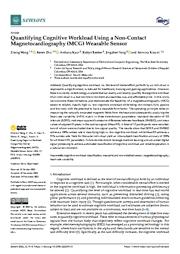A copy of this work was available on the public web and has been preserved in the Wayback Machine. The capture dates from 2022; you can also visit the original URL.
The file type is application/pdf.
Quantifying Cognitive Workload Using a Non-Contact Magnetocardiography (MCG) Wearable Sensor
2022
Sensors
Quantifying cognitive workload, i.e., the level of mental effort put forth by an individual in response to a cognitive task, is relevant for healthcare, training and gaming applications. However, there is currently no technology available that can readily and reliably quantify the cognitive workload of an individual in a real-world environment at a seamless way and affordable price. In this work, we overcome these limitations and demonstrate the feasibility of a magnetocardiography (MCG) sensor
doi:10.3390/s22239115
pmid:36501816
pmcid:PMC9735863
fatcat:zfggkdbn3zac3gzaj2ezts4xry

